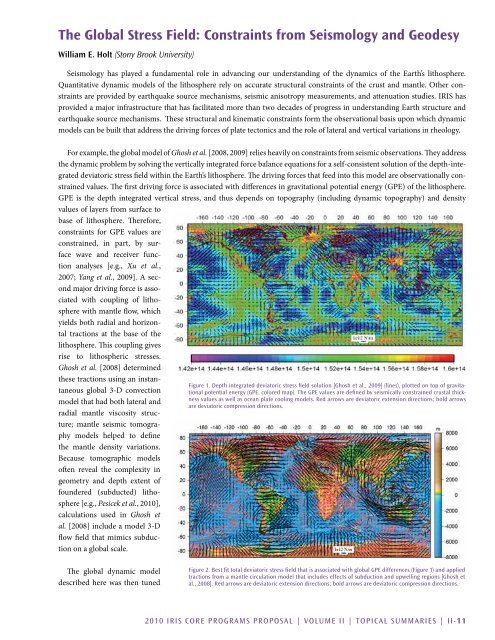Download Volume II Accomplisments (28 Mb pdf). - IRIS
Download Volume II Accomplisments (28 Mb pdf). - IRIS
Download Volume II Accomplisments (28 Mb pdf). - IRIS
Create successful ePaper yourself
Turn your PDF publications into a flip-book with our unique Google optimized e-Paper software.
The Global Stress Field: Constraints from Seismology and Geodesy<br />
William E. Holt (Stony Brook University)<br />
Seismology has played a fundamental role in advancing our understanding of the dynamics of the Earth’s lithosphere.<br />
Quantitative dynamic models of the lithosphere rely on accurate structural constraints of the crust and mantle. Other constraints<br />
are provided by earthquake source mechanisms, seismic anisotropy measurements, and attenuation studies. <strong>IRIS</strong> has<br />
provided a major infrastructure that has facilitated more than two decades of progress in understanding Earth structure and<br />
earthquake source mechanisms. These structural and kinematic constraints form the observational basis upon which dynamic<br />
models can be built that address the driving forces of plate tectonics and the role of lateral and vertical variations in rheology.<br />
For example, the global model of Ghosh et al. [2008, 2009] relies heavily on constraints from seismic observations. They address<br />
the dynamic problem by solving the vertically integrated force balance equations for a self-consistent solution of the depth-integrated<br />
deviatoric stress field within the Earth’s lithosphere. The driving forces that feed into this model are observationally constrained<br />
values. The first driving force is associated with differences in gravitational potential energy (GPE) of the lithosphere.<br />
GPE is the depth integrated vertical stress, and thus depends on topography (including dynamic topography) and density<br />
values of layers from surface to<br />
base of lithosphere. Therefore,<br />
constraints for GPE values are<br />
constrained, in part, by surface<br />
wave and receiver function<br />
analyses [e.g., Xu et al.,<br />
2007; Yang et al., 2009]. A second<br />
major driving force is associated<br />
with coupling of lithosphere<br />
with mantle flow, which<br />
yields both radial and horizontal<br />
tractions at the base of the<br />
lithosphere. This coupling gives<br />
rise to lithospheric stresses.<br />
Ghosh et al. [2008] determined<br />
these tractions using an instantaneous<br />
global 3-D convection<br />
model that had both lateral and<br />
radial mantle viscosity structure;<br />
mantle seismic tomography<br />
models helped to define<br />
the mantle density variations.<br />
Because tomographic models<br />
often reveal the complexity in<br />
geometry and depth extent of<br />
foundered (subducted) lithosphere<br />
[e.g., Pesicek et al., 2010],<br />
calculations used in Ghosh et<br />
al. [2008] include a model 3-D<br />
flow field that mimics subduction<br />
on a global scale.<br />
Figure 1. Depth integrated deviatoric stress field solution [Ghosh et al., 2009] (lines), plotted on top of gravitational<br />
potential energy (GPE, colored map). The GPE values are defined by seismically constrained crustal thickness<br />
values as well as ocean plate cooling models. Red arrows are deviatoric extension directions; bold arrows<br />
are deviatoric compression directions.<br />
The global dynamic model<br />
described here was then tuned<br />
Figure 2. Best fit total deviatoric stress field that is associated with global GPE differences (Figure 1) and applied<br />
tractions from a mantle circulation model that includes effects of subduction and upwelling regions [Ghosh et<br />
al., 2008]. Red arrows are deviatoric extension directions; bold arrows are deviatoric compression directions.<br />
2010 <strong>IRIS</strong> Core Programs Proposal | <strong>Volume</strong> <strong>II</strong> | Topical Summaries | <strong>II</strong>-11
















